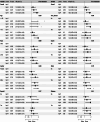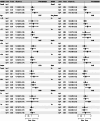Association between trajectory of triglyceride-glucose index and all-cause mortality in critically ill patients with atrial fibrillation: a retrospective cohort study
- PMID: 40640797
- PMCID: PMC12243274
- DOI: 10.1186/s12933-025-02838-x
Association between trajectory of triglyceride-glucose index and all-cause mortality in critically ill patients with atrial fibrillation: a retrospective cohort study
Abstract
Introduction: Previous evidence showed that triglyceride-glucose (TyG) index is strongly associated with poor prognosis in atrial fibrillation (AF) in the general population. In critically ill patients, physiological stress may cause rapid fluctuation in the TyG index, making single measurements insufficient for prognosis assessment. Furthermore, the impact of TyG index trajectories on outcomes in critically ill patients with atrial fibrillation has not yet been well elucidated. Therefore, our study aimed to assess the association between TyG index trajectories in patients with AF in intensive care unit (ICU) and all-cause mortality at 30-day, 90-day, 180-day and 365-day follow-up.
Methods: We used data from Medical Information Mart for Intensive Care (MIMIC)-IV database. Patients diagnosed with AF in ICU were enrolled. We applied group-based trajectory modeling to identify distinct TyG index trajectories, selecting the optimal model based on the Bayesian information criterion (BIC), Akaike information criterion (AIC), average posterior probability (AvePP), and clinical interpretability. Kaplan-Meier survival curve was used to compare the mortality in AF patients with different TyG index trajectories. Hazard ratios (HRs) were calculated to elucidate the association between trajectories and prognosis in Cox proportional hazard models. Restricted cubic splines (RCS) were used to assess the relationship between TyG index and outcomes.
Results: A total of 1,108 AF patients were enrolled. Four TyG index trajectories were identified including: (1) traj1 group (TyG index stable at low level), (2) traj2 group (TyG index slowly ascending at moderate level), (3) traj3 group (TyG index ascending then descending at moderate high level) and (4) traj4 group (TyG index fluctuate at high level). The Traj4 group demonstrated significantly higher mortality rates at all time points (30-day, 90-day, 180-day and 365-day) compared to other trajectory groups. In addition, Cox proportional hazard models indicated that patients in traj4 group had higher risk of mortality compared to those in traj1 group at 30-day (HR = 1.71, 95% confidence interval [CI], 1.14-2.56), 90-day (HR = 1.67, 95% CI, 1.17-2.39), 180-day (HR = 1.44, 95% CI, 1.03-2.06) and 365-day (HR = 1.44, 95% CI, 1.04-1.98). Meanwhile, the RCS indicated a linear association between TyG index and all-cause mortality.
Conclusion: In critically ill patients with AF, TyG index trajectories were significantly associated with 30-day, 90-day, 180-day and 365-day all-cause mortality. This suggested that TyG index trajectories could serve as a robust indicator for risk stratification and prognosis assessment in ICU patients with AF.
Keywords: All-cause mortality; Atrial fibrillation; Intensive care unit; MIMIC database; Triglyceride-glucose index trajectory.
© 2025. The Author(s).
Conflict of interest statement
Declarations. Ethics approval and consent to participate: The data was extracted from Medical Information Mart for Intensive Care IV (MIMIC-IV, Version 3.1). The collection of patient information and creation of the research resource was reviewed by the Institutional Review Board at the Beth Israel Deaconess Medical Center, who granted a waiver of informed consent and approved the data sharing initiative. Consent for publication: Not applicable. Competing interests: The authors declare no competing interests.
Figures






References
-
- Joglar JA, Chung MK, Armbruster AL, Benjamin EJ, Chyou JY, Cronin EM, et al. ACC/AHA/ACCP/HRS guideline for the diagnosis and management of atrial fibrillation: a report of the American college of cardiology/American heart association joint committee on clinical practice guidelines. Circulation. 2023. 10.1161/CIR.0000000000001193. - PMC - PubMed
-
- Wetterslev M, Hylander Møller M, Granholm A, Hassager C, Haase N, Lange T, et al. Atrial fibrillation (AFIB) in the ICU: Incidence, risk factors, and outcomes: the international AFIB-ICU cohort study. Crit Care Med. 2023;51:1124–37. - PubMed
-
- Hill MA, Yang Y, Zhang L, Sun Z, Jia G, Parrish AR, et al. Insulin resistance, cardiovascular stiffening and cardiovascular disease. Metabolism. 2021;119: 154766. - PubMed
Publication types
MeSH terms
Substances
Grants and funding
LinkOut - more resources
Full Text Sources
Medical

